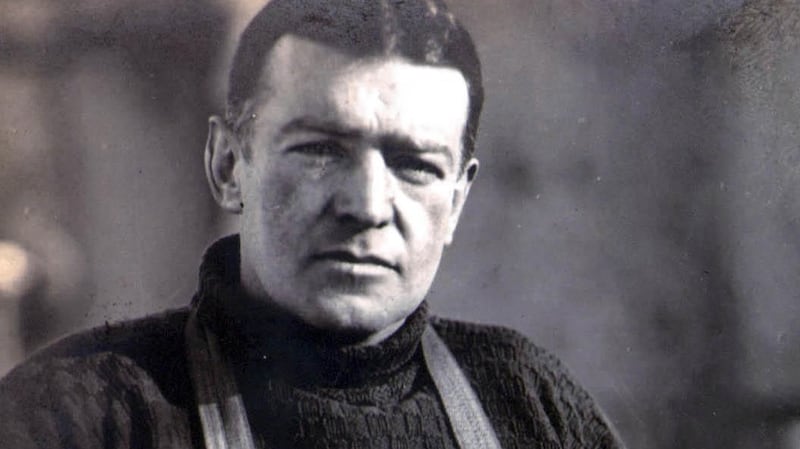The great explorer Ernest Shackleton died suddenly from a heart attack on January 5th 100 years ago on South Georgia in the Antarctic, for the exploration of much of which he had become famous. Although we Irish claim him for our own, he spent only the first 10 years of his life here.
He was born in Kilkea, Co Kildare, on February 15th, 1874, into a Quaker family that had moved there from Yorkshire in the early 18th century. His family moved to London in 1884, where the father practised medicine.
Ernest was educated at home and in a preparatory school before entering Dulwich College in 1887.
Three years later he joined the merchant navy and travelled to many parts of the world, including serving as third officer on a ship chartered to ferry British troops to South Africa during the second Boer War.
He didn't get on well with Scott, who was too authoritarian, but that didn't prevent him sailing again with Scott on what became known as the 'southern journey' in November 1902
Tiring of the merchant marine and seeking a more adventurous life, he volunteered for the national Antarctic expedition and was appointed as third officer to it in February 1901.
Its commander was Robert Falcon Scott and also among the crew that sailed on the Discovery was Kerryman Tom Crean, with whom Shackleton would again serve on later expeditions. He didn’t get on well with Scott, who was too authoritarian, but that didn’t prevent him sailing again with Scott on what became known as the “southern journey” in November 1902.
They travelled further south than had been reached up to that time but were forced to turn back and Shackleton was invalided home the following March due to ill health.
He married Emily Mary Dorman of Sussex in 1904; the couple had two sons and a daughter.
He served as secretary to the Royal Scottish Geographical Society in Edinburgh, failed to get elected to parliament for Dundee and became involved in an engineering company in Glasgow.
His real ambition, however, was to command his own expedition to the Antarctic. His Glasgow employer became his main supporter in this regard and, following fundraising, Shackleton set sail on what he called the “British Antarctic Expedition 1907” on board the Nimrod in August of that year.

Establishing base at McMurdo Sound, various parties reached the summit of Mount Erebus, the South Magnetic Pole and got within 97 miles of the South Pole itself, going 360 miles further south than Scott.
Returning to England to acclaim in March 1909, he was knighted, awarded gold medals by the Royal Geographical Society and the Royal Scottish Geographical Society, and parliament voted him £20,000 to cover the expedition’s costs. He published The Heart of the Antarctic and lectured in Europe and America.
Although Norwegian Roald Amundsen reached the South Pole in December 1911, Shackleton wanted to explore more of the Antarctic and also planned a transpolar expedition (not achieved until 1958).
The outbreak of war in 1914 might have disrupted his plans and he offered his ships Endurance and Aurora to the admiralty but was instructed to go ahead with the expedition.
Shackleton immediately began organising the rescue of the men on Elephant Island, succeeding after three failed attempts. It was an heroic achievement
Practically, it achieved nothing but, as David Murphy, who wrote the Shackleton entry in the Dictionary of Irish Biography, observed, “it came to symbolise [his] great skill as an explorer and leader of men”.
The Endurance got stuck in the pack ice of the Weddell Sea and broke up after 10 months. The crew camped on the ice floe and when that began to disintegrate after six months, they dragged three lifeboats over the ice to open sea and sailed to Elephant Island.
But Shackleton realised they’d not be rescued there and he and five crew (including Tom Crean) made an epic 800-mile journey, in a 22-foot boat, to South Georgia. He and Crean and Frank Worsley had to cross the island’s mountainous interior to reach Stromness whaling station. Shackleton immediately began organising the rescue of the men on Elephant Island, succeeding after three failed attempts. It was an heroic achievement.
He volunteered for the army and with the rank of major served on missions to South America and Russia.
Resigning his commission, he published South, an account of the Endurance expedition, in 1919 and returned to further explore the Antarctic in September 1921 on board the Quest.
It put into South Georgia on January 4th, 1922, and next day, Shackleton, who’d suffered from asthma and heart problems on the various expeditions, died from a major heart attack. At his wife’s request, he was buried at the whaling station at Grytviken on South Georgia.
He had received numerous awards, British, European and South American, during his life; areas in Antarctica and elsewhere are named after him and there is a fine statue outside the Royal Geographical Society in Kensington Gore, London. Athy museum in Kildare has a Shackleton display, and there’s a memorial plaque outside 35 Marlborough Street, Dublin, where he lived as a child.








